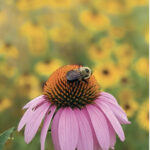 And in the blink of an eye, it is autumn.
And in the blink of an eye, it is autumn.
I like the sound of “autumn” much better than calling it “fall.” Fall? Did you scrape your knee? Our internal rhythm clicks and searches. We are somewhere between the primal urge to get ready for winter and the need to slow down and savor the beauty of changing foliage and magnificent sunsets.
But wait. We aren’t done gardening! Chores to do and spring plans to make!
Keeping up on the weeding is really important. These opportunists will be next spring’s seeders. After clearing areas, a 2- to 3-inch layer of mulch will make a huge difference in the populations next spring. Mulch is the best organic way to keep weeds at bay in landscaped areas.
Of course, after the fall foliage’s parade of beautiful colors, we may have a lot of raking to do. A small price to pay for having the luxury of trees in our gardens! Mother Nature has an awesome system in place. The leaves fall down, providing both weed control and soil-building compost.
Somewhere along the years, we lost complete contact with this perfect plan. We rake our leaves, put them in plastic bags (egads!) and send them out with the…*gulp*…trash. How sad really that we throw out this gardener’s gold. I rake mine into the center of the lawn, run over them with my mulching mower (bagging the clippings), and dump the contents right back on to my landscape beds. My leaves aren’t leaving!
Fertilizing in autumn is also good practice. I use Espoma fertilizer. Granular and organic, it is as easy as throwing handfuls around (read package for application rates). Spreading later in the season means the nutrients go to the root system. Stronger root systems equal stronger plants.
Give your vegetable garden some seasonal love, too. Clean up and discard any diseased plants, including shriveled up leaves on the ground. They are next year’s issues—spores typically overwinter in the dead foliage. After the cleanup, a soil test is an excellent idea to see what you will need for next year’s garden. Penn State provides an easy-to-accomplish test (available at Highland Gardens).
Many organic nutrients take three to six months to break down enough for plants to use them. Top the whole area off with a nice, thick cover (3 inches plus) of your chopped tree leaves. It’s all about the soil! A thick layer of newspapers (or your paper shredder contents) on top of the soil, under the chopped leaves, is earthworm paradise. A great way to recycle paper, it also provides excellent weed control. I also want to encourage you to plant your own garlic this autumn. It’s easy-breezy and inexpensive to plant—plus it keeps the neighborhood vampires at bay!
Time to bury some treasure! Planting flower bulbs this time of year is what gives your garden the wow-zee factor next spring. I like to plant bulbs several at a time in the same hole. Makes the diggin’ go faster, and the result is clusters of flower bouquets. Once you have dug the hole, it is always a good idea to throw a few handfuls of…you guessed it…chopped leaves in to help the soil at a deeper level. Point goes up, like a Hershey’s kiss. When planting in these clusters, the bulbs can be quite snug in the hole, nearly touching. Of course, as with anything, there are qualities of bulbs to choose from. Cheap ones are puny and give puny results. Look for fat, plump bulbs. Size does matter!
I always need to share a bit of lawn information in these chats. Autumn is an excellent time to give your lawn some extra love. A soil test is the number-one investment to a healthier lawn. This test allows the knowledge (not the guessing!) of nutrient levels and proper pH, both of which are critical to good grass growing. Are we stuck in the pasture being sheep, buying bags of this or that because it seems like the thing to do (perhaps because the commercials tell us to)? The soil test results make for precise additions—saving both time and money. The grass responds by being healthier and more able to hold its ground against weeds.
Gypsum is another great organic nutrient to spread now. It breaks up clay and adds calcium to the soil. Choose organic additions every time to make the soil better, thus the grass better. Aerating your lawn is another excellent thing to do. It involves making holes throughout, allowing water and nutrients to reach deeper levels. This, in turn, helps improve clay soils. It’s all about the soil!
Happy Autumn!
Erica Shaffer is a nursery manager with 24 years of experience at Highland Gardens, Camp Hill. She’s also a proud landscape designer, consultant, lecturer, writer, blogger and tree-hugging plant geek. www.highlandgardens.org.





